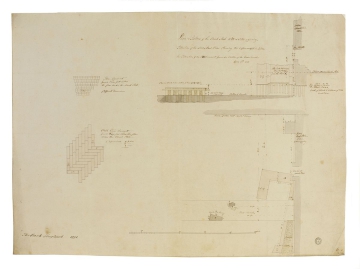
Browse
Reference number
Purpose
Aspect
Scale
Inscribed
Signed and dated
- April 6th 1798
Medium and dimensions
Hand
Notes
The section at the top of the drawing shows the steps leading up to the grated entrance to the Bank Stock Office's cellar beneath the north wall chimney piece, visible in SM volume 74/42 and SM volume 74/36. The rest of the section shows an old wall adjoining the Bank Stock Office and piles of plank for the foundation of the New Four Per Cent Office (this may be a reference to the Consols Transfer Office, rather than the Four Per Cent Office built to the Bank Stock Office's east end in 1797).
The plan at the bottom of the drawing also shows the north wall of the Bank Stock Office cellar, plus the inside of the wall next to Bartholomew Lane, and the plan of the old wall adjoining the Bank Stock Office's cellar labelled in the section, as well as details of the old pavement found in the new 31-foot long trench running north from the Bank Stock Office's north wall. Adjoining this north wall, at the bottom of the drawing, is an area found to be filled with rubbish. On the drawing's left are two details drawn of pavement found nine feet under the floor of the Bank Stock Office, the top drawing being of stone paving and the bottom of brick.
Level
Sir John Soane's collection includes some 30,000 architectural, design and topographical drawings which is a very important resource for scholars worldwide. His was the first architect’s collection to attempt to preserve the best in design for the architectural profession in the future, and it did so by assembling as exemplars surviving drawings by great Renaissance masters and by the leading architects in Britain in the 17th and 18th centuries and his near contemporaries such as Sir William Chambers, Robert Adam and George Dance the Younger. These drawings sit side by side with 9,000 drawings in Soane’s own hand or those of the pupils in his office, covering his early work as a student, his time in Italy and the drawings produced in the course of his architectural practice from 1780 until the 1830s.
Browse (via the vertical menu to the left) and search results for Drawings include a mixture of Concise catalogue records – drawn from an outline list of the collection – and fuller records where drawings have been catalogued in more detail (an ongoing process).

